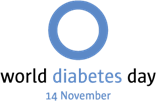

World Diabetes Day was created by the International Diabetes Foundation and the World Health organisation in 1991 as a response to growing concerns about the rise in diabetes and its danger to health. The event is marked annually on the 14th of November, the birthday of Sir Frederick Banting, who along with Charles Best discovered insulin in 1922.
‘Access to Diabetes Care’ is the 2021-2023 theme and ‘Education to Protect Tomorrow’ is the specific theme for 2022. Access and education go hand in hand because one of the most important ways to improve access to diabetes care is through increasing awareness about the condition. By raising awareness of diabetes, prevention, early detection, and effective treatment can be ensured.
For World Diabetes Day, this year at PHSI, we are raising awareness with facts and figures about diabetes, shining a spotlight on the amazing research of PhD candidate Anna Boath and signposting you to educational resources on diabetes.
What is Diabetes?
Diabetes is a lifelong chronic condition that causes an individual’s blood sugar level to become too high. The two main types of diabetes are: Type 1 and Type 2 diabetes.
With Type 1 diabetes, the body’s immune system attacks and destroys cells that produce insulin. Although it can affect adults too, this type of diabetes is the most common in children. With Type 2 diabetes on the other hand, the body fails to produce adequate insulin or the body’s cells do not reach to insulin. This type is more prevalent among adults aged over 40 although more younger people and children are getting diagnosed with the condition. During pregnancy, some women may be unable to produce adequate insulin to absorb the high levels of blood glucose produced by their body, leading to gestational diabetes.
Did you know? Diabetes Facts and Figures!
One out of 10 people GLOBALLY are affected by diabetes. In 2021, 537 million adults that is 1 in 10 adults were living with diabetes and these figures are expected to increase to 643 million by 2030 and 783 million by 2045. Diabetes also affects children and there are over 1.2 million children and young people aged between 0-19 years globally living with type 1 diabetes. In 2021, there were 6.7 million deaths from diabetes. Just over 40% of diabetes cases remain undiagnosed with the majority of these being Type 2 diabetes.
Spotlight on Diabetes Research at Population Health Sciences Institute

Maternal Health by Anna Boath, PhD Candidate
I am currently a 4th year PhD student at Newcastle University researching health in pregnancy. Researching health in pregnancy particularly interested me as the health within pregnancy impacts the woman herself and can impact health of the child across their lifespan. Therefore, health throughout pregnancy affects every single person. Research in pregnancy is crucial to provide safe and effective care and treatments for women and their children, with research being carried out in a way that promotes access to all women.

My research has a focus on gestational diabetes, which is a type of diabetes that occurs during pregnancy and tends to resolve around 6 weeks after giving birth. Understanding and researching gestational diabetes is important as across the world the number of women developing gestational diabetes is rising. Also, women develop gestational diabetes are at increased risk of developing type 2 diabetes in later life. Conducting more research in the area means we can provide better care for women.
In every pregnancy, the placenta causes a degree of insulin resistance; this means that during pregnancy all women don’t have as much ability to absorb sugar from their blood stream; however, this is a clever mechanism means more sugar goes to the baby and helps it to grow! In gestational diabetes, there is too much of this insulin resistance, which keeps blood sugar levels too high and for too long, which can have an impact on mum and baby.
Interestingly, we still do not know the exact cause of gestational diabetes, but we do understand some of the risk factors. One of the risk factors that is thought to be important is an increased body mass index (BMI), which women have calculated when they have their first midwife appointment. BMI can be used to indicate weight status, with a higher BMI considered a higher risk for gestational diabetes. However, we know that using BMI on individuals doesn’t accurately reflect total body fat or how body fat is distributed. Using BMI alone also does not select all women who go on to develop gestational diabetes.
My research looks at how we can use different measures of body fat and body fat distribution and how these might be better for selecting women that might benefit from extra care in pregnancy. Different measures we can use include waist circumference, which indicates how much body fat someone has around the centre of their body; this can be a good indicator of body fat that is associated with disease development.
Being able to understand which women might develop gestational diabetes would along health care professionals to potentially offer care such as dietary and physical advice which may be able to prevent the development of gestational diabetes.
Links to Educational Resources
- Understanding Diabetes: This is a free online learning platform that provides information about diabetes, so that you are more confident in preventing or managing it: https://www.understandingdiabetes.org/
- What is Type 1 Diabetes? 2 min guide: https://www.youtube.com/watch?v=C3AQIfgthh4
- What is Type 2 Diabetes? 2 min guide: https://www.youtube.com/watch?v=4SZGM_E5cLI
- Find out your risk for Type 2 Diabetes
- Learn more about diabetes: Diabetes UK
- Signs and Symptoms of Diabetes.